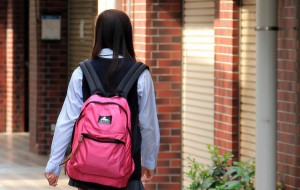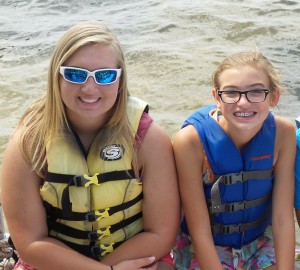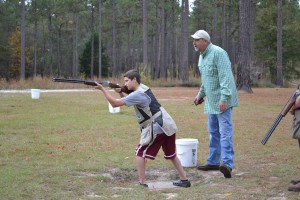by Prudence Caskey | Sep 5, 2015
Who doesn’t want a little more time? I am always looking for ways to help me get more done in the time I have. Over the years, I have found some great applications that I would like to share with busy 4-H parents and volunteers:
- ANYLIST—this is a great application allowing you to create lists. I have a list I have named, “My Grocery List.” The neat thing about it is when I say to Suri, “add milk to my grocery list,” she does it! It makes it easy to compile a grocery list and I don’t even have to find a piece of paper.
- MY FITNESSPAL—this application allows you to log everything you eat and helps you stay accountable. It will also talk to your exercise tracker to offset the amount of calories you can eat versus the calories your burn each day. The BODY TRACKER application can keep track of body measurements and how much muscle you gain and how much fat you lose.
- COUNTDOWN—this application allows you to enter upcoming events from your calendar and keep track of how many weeks, days, hours, minutes and even seconds to deadlines! This allows you to prioritize based on what is due next, whether it be birthday shopping, a 4-H club meeting, or homework assignments.
It can be daunting for parents to keep track of work, family, church, sports, and school calendars. Sharing calendars can help see where everyone is at a glance. There are many applications that are free to help you get organized and save time- these are just a few great examples. Remember, not every application is for everyone. If I find that an application just doesn’t work for me, then I erase it. We all have different opinions on which applications will work best. For instance, my husband likes Weather Channel but I prefer AccuWeather. We both get the weather, just through different applications. Check out some of these applications to save time and stay organized this 4-H year!
by Melanie Taylor | Aug 15, 2015
 As summer break comes to a close, many children will be experiencing changes in their school experience at an entirely new school. Be sure to make the transition as easy as possible by talking with your child about the positive experiences they may have this new school year. Below are a few tips on how to help you and your child adjust to such a big change with the least amount of stress.
As summer break comes to a close, many children will be experiencing changes in their school experience at an entirely new school. Be sure to make the transition as easy as possible by talking with your child about the positive experiences they may have this new school year. Below are a few tips on how to help you and your child adjust to such a big change with the least amount of stress.
Introduce yourselves to the new school:
• Make sure that the new school expects you: register your child before the first day of class
• If possible, visit your child’s new school: try to meet the office staff, principal, and teachers before the transition to establish a personal connection and to help them prepare for your child’s arrival
• Some schools have “welcome packets” to give to new families; if not, try to get basic information, such as what time the school day begins and ends, the procedure for lunch (can your child buy lunch, does the school provide snacks, etc.), transportation procedures (what’s the bus schedule), and information about health services and emergency procedures
• Try to meet other school families; if you have an elementary school-aged child, see if you can arrange a “play date” with another child in the same grade (preferably before the first day of school.)
• Become involved in your child’s new school. Consider joining the PTA, or volunteering at the school; the more involved you are, the more your child will feel like his or her school is important to you and the more connected he or she will feel.
Help your child adjust:
• Make sure your child understands the reasons for changing schools; if you have an older child, try to give him or her as much “advance notice” as possible so that he or she will have time to adjust to the idea
• If time allows, show your child his or her new school and the surrounding neighborhood; see if you can arrange for a student to show your child around the school and introduce him or her to teachers and staff; some schools have a “buddy system” or other ways of helping your child meet other children in the school
• Make sure the school has what it needs to make the best decisions concerning your child’s classroom placement and academic and social needs; confirm that the new school has obtained your child’s educational, health, and other relevant records
• Be patient. It is perfectly normal for a child to feel anxious, scared, or irritable during times of transition. Let your child know that you understand that this is difficult; take the time to listen to his or her concerns, and spend time together while your child develops new school connections and friendships
• Stick to your routine. If rapid changes have left your child upset, knowing what’s expected at home can provide a comforting calmness. Encourage your child to feel good during this stressful time: encourage (or enforce) a schedule including a regular bedtime and a healthy breakfast.
• If your child had a negative experience at his or her last school, speak positively about the fresh opportunity that the new school presents. Help your child develop new goals for school success
• If your child is young, or is particularly nervous, consider accompanying him or her to school for the first few days
• Encourage your child to become involved in school activities, sports, or after school clubs
• Make sure your child has what he or she needs for the first day of school (ask the school for a classroom supply list.) This will make your child feel more included on the first day.
• Help your child identify something good about his or her new school, and offer comfort and reassurance that adjusting to a new school takes time.
One of the most important steps as a parent is to realize that moving to a new school is a very big deal for many children. There may be a few bumps in the road along the way, but remember to be patient, understanding and there for your child and he or she will eventually adjust. This adjustment could take up to 6 weeks. If the adjustment continues to be struggle after several months be sure to consult with a school counselor to help with any further assistance.
Do you have a skill or passion that you would like to teach the next generation? Consider becoming a 4-H volunteer. 4-H offers a wide variety of opportunities for volunteers to make a difference in their community, or even at their school. Next week, our blog post will focus on ways that you can volunteer through 4-H school programs. To find out more about volunteer opportunities, contact your local UF IFAS Extension Office, or visit http://florida4h.org/volunteers.
by Prudence Caskey | Aug 7, 2015

Back to school shopping can be a teachable moment for your kids about money management
In many parts of Florida, school starts in less than a week! Depending on where you live, what school your children attend, and what grade they are in, back to school supplies can cost the average family anywhere from $100 to $500! Keeping this in mind, it is time to start thinking about a strategy for your back to school shopping. The good news is, the back-to-school tax holiday has been extended from three days to ten days this year!
The tax holiday will begin August 7 and run through August 16. Tax-free items include; clothing, footwear, wallets, bags that cost $100 or less, school supplies that cost $15 or less, and the first $750 of the cost of personal computers and related accessories. Now that you know when and what to shop for, here are some tips on how to shop to make the most of every dollar:
Have a plan
- Get the supply list for your child’s school and make notes.
- If you have more than one child, compile a combined list. If your son needs 6 folders and your daughter needs 6 folders, on your list, simply write “12 folders”. This will cut down on the time spent on shopping.
Have a budget
- Make a list of what your children will need and get an idea of how much it will cost.
- Use back to school shopping as an opportunity to help your child learn about prioritizing and budgeting. Tell your child how much they have to spend for specific items. For example, they can spend $20 for a backpack, $50 for shoes and $200 for new clothes. If they want the $90 pair of shoes, they will need to get a less expensive backpack or spend less on clothes. This will help you stay within your budget and aid in teaching your children some financial skills. It is a win-win!
Shop around
- Many stores are having sales right now. If you approach back-to-school shopping like you might do “Black Friday” shopping, you can have a lot of fun with it!
- Check ads in the Sunday paper for sales on items on your list. Many papers will also have coupons for wipes, paper towels, and other items often found on preschool or elementary school lists. You can also use online coupons, e-coupons, and store loyalty cards for even more savings.
- Check out stores you may not have considered in the past such as office supply stores, dollar stores, and even thrift stores.
Plan for next semester
- Now is the time to get all of the supplies you need at a great price. If you find a good deal on some basics, stock up for next semester on items like glue sticks, pens, folders, and notebook paper.
Going back to school can be an expensive time of year; however, it doesn’t have to be with a little planning and budgeting. Put the same energy into back to school shopping that you might do with Christmas shopping. Make it a sport! Remember for next year, at the end of the summer, school is approaching and you can plan for it. If you are interested in financial management, budgeting, or shopping, consider becoming a 4-H volunteer! We need volunteers to share their knowledge and skills with youth to teach youth about financial literacy and consumer choices (smart shopping). If you are interested, contact your local UF IFAS Extension Office, or visit http://florida4h.org./volunteers.
by Julie Pigott Dillard | Jul 24, 2015

Do you know how to properly fit a life jacket? Photo credit Washington County Extension.
Like Dr. Seuss said, “It’s fun to have fun, but you have to know how.” With over 11,000 miles of rivers, streams and waterways, 4,136 miles of beaches, coastlines, and shorelines, and 4,308 square miles of total water area, Floridians can enjoy time on the water year-round. Whether you’re out cruising the river, fishing for Red Snapper in the gulf or wakeboarding on a spring-fed lake, you should be thinking about water safety.
The number one rule in boating and water sports safety is to wear a life jacket. According to safetykids.org, 77% of fatal boating accidents were drowning victims, and 84% of those victims weren’t wearing life jackets. Florida law states that all children six years of age and under must wear a life jacket, but all youth can benefit from wearing a properly sized, snug fitting U.S. Coast Guard approved life jacket to ensure safety in and around water and while boating.
You might think that life jackets are useful only in rough conditions, but one-half of all water related fatalities happen in calm waters. So, when would a life jacket save lives?
- When a boat has capsized in rough water.
- When a boat sinks in heavy sea conditions.
- When a person is thrown from a boat after a collision.
- When an injury occurs.
- When a person is tossed into freezing water.
- When a person is thrown off balance and into the water fishing.

According to Florida law, youth ages 6 and under must wear a life jacket, but everyone can benefit from wearing one. Photo credit Washington County Extension.
- When a carbon monoxide fumes cause unconsciousness.
- When a person is unable to swim because of heavy, waterlogged clothing.
To ensure you have a properly fitting life jacket:
- Choose a life jacket for your size and weight.
- Correctly fasten all straps and buckles.
- Hold your arms up in the touchdown pose.
- Ask someone to gently pull up on the tops of the arm openings.
- Check there is no excess room above the arm opening and to make sure the jacket doesn’t ride up over your chin or face.
Remember, fun items like pool noodles, floats and water wings should never be substituted for a well-fitting life jacket. Consider a life jacket like any other piece of sporting equipment that requires maintenance. Check it yearly for wear and tear and for buoyancy, and throw away leaky, faded, waterlogged and misshapen life jackets. Football players wear helmets, drivers and car riders wear seat belts – responsible boaters should wear life jackets.
If you have a passion for fishing or boating, consider becoming a 4-H Sports fishing project leader. We have some wonderful curriculum and resources for volunteers who would like to share their fishing expertise with youth. To find out more, contact your local UF IFAS Extension Office, or visit http://florida4h.org/volunteers.
Your opinion matters! Take this short survey to help us improve our blog: https://ufl.qualtrics.com/SE/?SID=SV_3gtLKjqia3F75QN
by ewestbrook | Apr 24, 2015

A two liter soda bottle with the top cut off makes a great mini compost bin. This is a a new batch with soil mixed in to experiment with jumpstarting the composting process.
With the promise of fresh vegetables just around the corner, now is a great time to think about starting a compost pile to save money on fertilizer and potting soil for your garden. Composting makes an excellent (and environmentally friendly) project for youth. It can save you money on commercially sold soil amendments as well as improving the quantity and quality of your vegetable harvest. Compost is simply organic material that has been broken down by living organisms until it can be used by plants as nutrients. This decomposed material is called humus and it is a great natural fertilizer. All that you need to get started composting are a few key ingredients:
- An even mix of nitrogen rich “green” organic materials and carbon rich “brown” organic materials. Greens include items like fresh grass clippings, manure and vegetable scraps from the kitchen. Browns are things like dead leaves, straw, or newspaper.
- Moisture is needed for the organisms that break the compost down to live, but not too much. The pile should be damp, not soggy.
- Air should be introduced to the compost periodically by mixing it up.
- Time is necessary for microorganisms to turn the brown and green materials into humus.
There are several methods of composting, from something as simple as a pile in a corner of your yard to a commercially sold rotating bin. Whatever composting system your group chooses the basic method of creating a good composting mixture is the same. Simply make even layers of browns and greens and moisten the pile slightly with water. Over the course of the next few weeks, microorganisms will begin decomposing the mixture, releasing heat as a byproduct. Temperatures will sometimes to as high as 140° F. The mixture will reduce in volume by nearly half as it breaks down. Once the mixture is entirely composted it will be close to ambient temperature and will resemble fine dark rich soil with some large clumps. To test the compost, plant a few fast growing radish seeds in it. If they don’t grow or are unhealthy it means bacteria are still decomposing the compost mixture and competing with the plants for nutrients. If the plants are healthy the mixture is ready to use in the garden either by spreading it like a mulch, mixing it into the soil or making a compost tea.

A two liter soda bottle with the top cut off makes a great mini compost bin. This is a a new batch with soil mixed in to experiment with jumpstarting the composting process.
As an alternative to a large compost pile or bin you can create mini compost mixtures in a variety of recycled containers, such as a mason jar or empty 2-liter bottle. These are great for small classroom projects, science experiments and take home projects. Make sure to that the compost can be mixed and is getting air. Keep it in a sunny spot so it is warm enough for the microbes to work. Here are some ideas to extend this activity into a project to learn the science behind composting:
- Help youth research composting methods and choose the best one for them. Encourage them to consider things like cost, labor and time when deciding the best method.
- Try different types of composting methods and mixtures. Have the youth make predictions about which mixture will be the most effective. Have them design an experiment to find out what happens if more greens are in a composting mixture than browns? Or, why would one method decompose faster than the other? What is the fastest method of composting?
- Keep records and observations about the compost as it decomposes. By measuring factors like temperature, texture, smell and look youth learn the value of recordkeeping as they use the data they collected to research the best composting methods.
- Have the finished compost soil tested. Ask your county 4-H Agent to invite a UF/IFAS Agriculture or Horticulture Agent to help perform the test and explain the results to the group.
For more resources to help your club or group to learn composting by doing visit these sites:
Do you have a passion for gardening that you would like to share with others? Last year, nearly 20,000 youth participating in the 4-H Gardening Project. This would not have been possible without our 4-H volunteers. If you would like to help the next generation develop gardening skills and an appreciation for agriculture and the environment, consider becoming a volunteer. To find out more, contact your local UF IFAS Extension Office, or visit http://florida4h.org/volunteers.
Your opinion matters! Take this short survey to help us improve our blog https://ufl.qualtrics.com/SE/?SID=SV_3gtLKjqia3F75QN.
by Heather Kent | Feb 20, 2015

Gary Clark, Sure Shots 4-H Club Leader
In Washington County, the name Gary Clark is synonymous with the 4-H Shooting Sports program. Gary decided to start a club because he wanted to do something that would benefit the next generation of hunters, conservationists, and shooting sports enthusiasts. When asked what he most enjoys about being a 4-H volunteer, he replied “It is a way to give back to a community that has always supported me.’
Gary takes his role as a mentor and role model very seriously. “There are young people watching and listening to your every word, not so much for guidance and inspiration, but to see if you are walking the talk. Working with young people today is not so much about passing along knowledge and teaching life skills as it is about making investments in their lives. Showing the same care and concern for every youth you are working with, no matter what skill level or potential, is critical to that young person viewing themselves as successful.” Relationships with caring adult volunteers is one of the Essential Elements of Positive Youth Development that 4-H is built upon.
I believe that we all have not only an opportunity, but an obligation to help to make our communities a better place to live. I think back on the people who gave their time and resources to coach and mentor me when I was young and I am thankful for the generosity. No amount of time spent investing in the lives our youth is ever wasted!
Seeing kids succeed is what keeps Gary motivated to continue his volunteer service. “Our teams have been extremely successful, but most of that success is measured on the personal level. When you see a student achieve a new personal best or overcome an obstacle that has held them back and you see that little light go off inside their brains, you can’t help but be inspired and so proud of their achievements.” Gary also finds motivation when his 4-H Alumni return to the program as volunteers. “Two former students are also now certified coaches in the program and help out on a regular basis. Seth Pemberton is one of those youth. Seth shares, “Gary has positively impacted my life through 4-H shooting sports by making me strive for excellence, work hard, and give my best.”
Gary shares what inspires him most about being a volunteer is working with youth who would otherwise not have the opportunity to be part of a team. “Unlike so many other sports, shooting is a pretty level playing field- it isn’t only for the most athletic, the smartest, the most popular or the kid that can afford the best equipment. Every member comes into the program with an equal opportunity for success. It is all based on their commitment, focus, and [goals they set for themselves].”
Gary is very modest about his impact his club has on youth, but Julie Dillard, the Washington County Extension Director says, “Gary’s dedication to his community and his 4-H’ers is inspiring and has been the key to the success of Sure Shots 4-H Club. He encourages, praises, corrects and motivates each individual to be his or her best.”
When asked what he feels youth get out of the 4-H Shooting Sports program, he says “They learn about respect for others, commitment, teamwork, goal setting, cooperation and even how to handle disappointment [sportsmanship]. All of these traits come from being part of a program like 4-H. I do not know of any other organization that offers so many different ways for youth to be involved in their community in a structured, safe and nurturing environment that is built on the values and principles that we all hold so dear. I also believe that these skills will follow them throughout their adult lives as well.” Gary’s experience with 4-H is backed by research. The Tufts Study of Positive Youth Development found that compared to other youth, 4-H members are:
- Four times more likely to contribute to their communities
- Two times more likely to be civically active
- Two times more likely to participate in science, engineering, and technology programs during out of school time; and
- Two times more likely to make healthier choices.
Would you consider making the investment of a lifetime by becoming a 4-H volunteer? 4-H offers a variety of volunteer roles based on your interests and schedule. To find out more about being a volunteer, contact your local Extension Office or visit http://florida4h.org.

 As summer break comes to a close, many children will be experiencing changes in their school experience at an entirely new school. Be sure to make the transition as easy as possible by talking with your child about the positive experiences they may have this new school year. Below are a few tips on how to help you and your child adjust to such a big change with the least amount of stress.
As summer break comes to a close, many children will be experiencing changes in their school experience at an entirely new school. Be sure to make the transition as easy as possible by talking with your child about the positive experiences they may have this new school year. Below are a few tips on how to help you and your child adjust to such a big change with the least amount of stress.



